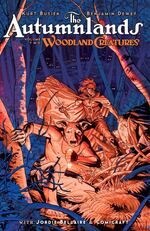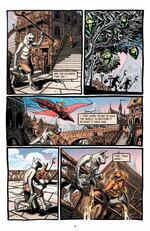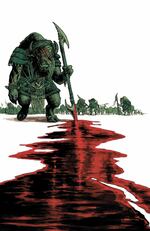
Kurt Busiek has been writing comic books since 1982. He's had his hands on so many characters: The Avengers, Superman, Batman, Iron Man and Conan the Barbarian. He's also the author of a masterful, long-lived and much-loved superhero anthology series, "Astro City."
Busiek's recent series "Autumnlands" is a fantasy epic getting critical raves for its vivid world and social commentary. Brought to striking life by artist Benjamin Dewey and colorist Jordie Bellaire, "Autumnlands" opens in a futuristic world where anthropomorphized animals are king and humanity as we know it is only a distant memory. Busiek and Dewey, who live in metro Portland, came by to tell us about the story that Busiek had been thinking about for nearly 20 years.
Here are some highlights from our interview with Busiek and Dewey.
Q&A with Kurt Busiek and Benjamin Dewey
April Baer: This series is as imaginative as anything you’ve ever done. There’s some wonderful departures for those familiar with 'Astro City' and other titles. The premise is the 'Autumnlands' is a land of splendid floating cities high above the earth. And the beings who live in them are highly educated, living these very orderly lives. There’s a definite power hierarchy and yet there’s cracks developing in the facade of their society. Could you talk about how you developed it?
Kurt Busiek: There's a DC comic series by Jack Kirby called 'Kamandi,' which is a science fiction series about the last boy on earth in a world of animals. ... For one reason or another DC would never let me write 'Kamandi.' So I just thought: I want to do a series like 'Kamandi' that has what I like about it without being a Kirby series.
AB: What were the elements of 'Kamandi' that captured your young mind?
KB: It's the animal society. You're traveling through this world, but there's elements of what came before. And this barbaric society has developed that has different warring kingdoms and animal societies. I started thinking about pushing that further. Then I read a collection of Jack Vance stories called 'Tales of the Dying Earth.' It looks like science fiction but it's about the fading days of earth where we've drifted away from science into magic. There's all this sorcery, rococo culture and weird spells. I thought if you did a Kamandi-like world that wasn't science fiction but fantasy with magic, with floating cities and people in ornate worlds, then automatically it's going to feel different.
Driving down here today, I was thinking about the fact our first book is an adventure story and a survival story. But cutting through that is a story about injustice. The cities above the plain are treating the tribes below them as serfs.

Courtesy of Image Comics
AB: The citizens of the cities are things like bears, warthogs, dogs and giraffes who have families, jobs and societies. And there are whole other tribes of goats and buffalo living down below basically as serfs to the aerial dwellers.
KB: Yeah, the people who live in the cities above the plain are powerful, privileged people who control a lot of magic; therefore they have dominion over everyone around them. And they're jerks. In our first story, there's a battle for survival between the survivors and the people of the plains below.
AB: Ben, we’ve talked before about your considerable skill imbuing inanimate objects with emotions and stories of their own. I’ve never seen you do so much with facial expression, and you’re doing it with animals.
Benjamin Dewey: Kurt gives me a lot of fuel to put in the jet. There's definitely a clear and emotional intent. ...If you don't have the same facial cues that we see in humans and are so used to seeing, you can hint at them. And that combined with Jordie's coloring and Kurt's dialogue or things we'll discuss for framing can make a big difference.
AB: One of the main characters is Dunston, who’s a bull terrier. At one point another character says to him, ‘Don’t you try that on me. It doesn’t work.’ and I read that line and realized Dunston is giving him puppy eyes.
There are so many jokes about using these sentient animals as characters. There’s this great moment in Vol. 1 where you realize the beasts of burden in this world: the draft horses and plow horses are dinosaurs. How did you come up with that?
KB: That was something we talked about too. That and insects. You can have it be really complicated too if you work in the prey/predator relationships. So we had to think of something outside that scope. And, Kurt, you had made that dinosaur suggestions, but they're some strange hybridization.
BD: Some of these dinosaurs grow wool ... and part of that is this is a world the gods have made. As one of the gods said, 'It would be cool if we had dinosaurs instead of cows.'
KB: That and the degree to which creatures are anthropomorphized has to do with that too. And story reasons we can't get to yet.
AB: The conundrum the characters are facing in Vol. 1 is the magic is dying off and nobody knows why. Kurt, is there something you wanted to say here about how people deal with crisis?
KB: Eventually. I didn't start out doing that. I started out with the idea: There's this group of magical animal people. How do we put a human in the middle of that? They reach back in time and pull this great champion from the past to solve their problem today.

Courtesy of Image Comics
AB: To try to revive magic, they summon this mythical champion who they believe brought magic to their world.
The character we know of as the champion, Learoyd, everyone’s in the dark about what he is ... they’ve never seen anything like him before. He’s scaleless, wingless, and talonless. Ben, can you talk about how you heightened the drama of that visually?
BD: Certainly a lot of conversations with Kurt about what we wanted to see. And I think the fact he is supposed to represent a feral quality they've buried deep down but because he's a particular type of action hero ... that seems incredibly shocking to them.
The choices of him jumping up onto things and use his weight to knock characters off balance. ... Those are suggestions Kurt offered up. Like if these bison are huge and powerful but standing on these tiny legs, he’s going to see that and knock them out from under them in the most savage way possible. And that’ll send things running because they don’t know how to handle this guy either.
And when he shows up he’s completely soaked in blood.
AB: You really get the sense he’s more animalistic than these animal characters so far.
KB: That was one of the opening questions that I wanted to ask: Who's the animal here?
AB: And he’s completely naked. We should mention that too!
KB: As he was being designed, one of the things I pushed for Ben was, he's not Conan. Don't make him look like a full back. He's a well-muscled soldier, but he's realistic. Think about him as a lean mean fighting machine but not Captain America.
BD: He's not bulking up and taking supplements. It's all utilitarian.
KB: And I wanted him to not be a superhero.